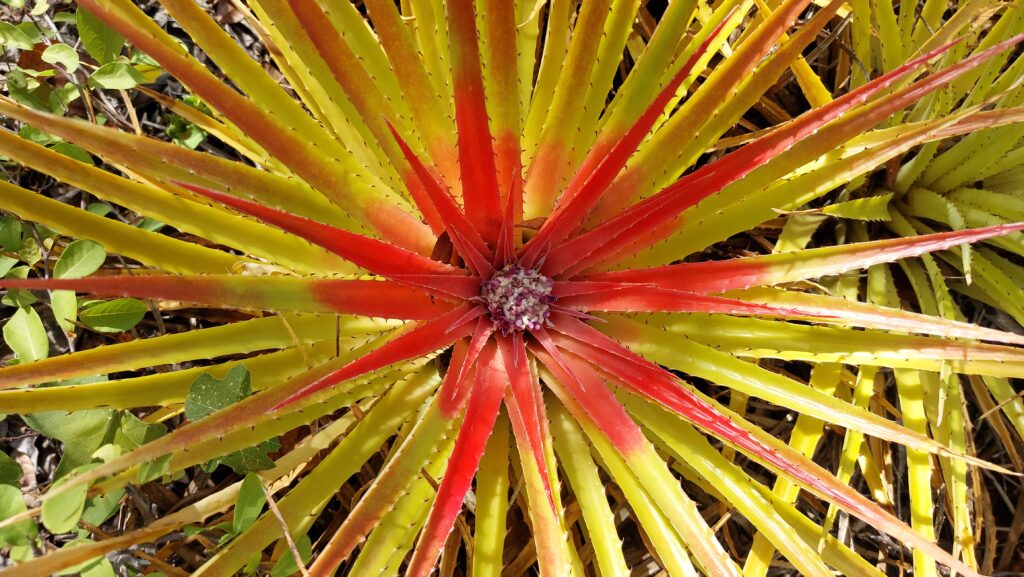At Christmas the inner rosette of one of the Teku di mondi plants (Bromelia humilis) was bright red with a characteristic white cotton-like ball in the middle. Our teku would bloom, perhaps not at Christmas in the beautiful characteristic Christmas colours but on New Year’s Eve. To ring in the new year with a beautiful firework of clashing colours. Because whoever thinks that the red rosette is the flowers, is very wrong. It is nothing more than a sign that should lead potential visitors to the real treasure. Namely the lilac purple flowers that bloom in the afternoon in the white heart amidst all those red colours, with bright yellow pollen as a kind of extra touch of colour against it. There is no plant that colours so extensively clashingly in our nature. Especially when the plants start to bloom en masse, it is a cacophony of cheerful colours in the mondi.
Spiny
The Teku di mondi is a plant that grows on the islands of the former Netherlands Antilles, Trinidad and Tobago and in Venezuela. The sharp spines on the rosettes are a potent defense mechanism, where small animals such as lizards and insects like to hide. A predator can hardly reach them. The plant is quite resistant to the harsh dry climate of our island where there is little rain. And in ecology it serves both as a food plant and as a ground cover. No luxury on an island where the topsoil, the fertile layer of soil that lies on top of the rocks, is very thin. Nutrients must be preserved as much as possible. And dead plant material such as twigs and leaves must be recycled to preserve the valuable vitamins and minerals as much as possible.
Because this plant can cope well with poor food soils, it is common in places where the soil is very poor. There it forms kilometres of carpets of plants that grow close together. Now that very thin fertile soil is exactly what we as ‘smart’ people remove with big loaders when supposedly ‘cleaning’ a piece of land. And then having to throw a lot of money at it to let a coconut palm grow in it.
English name: Ground bromeliad
Papiamentu name: Teku / Teku di Mondi
Scientific name: Bromelia humilis
Occurrence (ABC islands): Aruba, Bonaire and Curaçao


Vuurwerk in kleur
Met de Kerst was de binnenste rozet van een van de Teku di mondi planten ( Bromelia humilis ) felrood gekleurd met een karakteristiek wit katoen achtig bolletje in het midden. Onze teku zou gaan bloeien, wellicht niet met de Kerst in de mooie karakteristieke kerstkleuren maar wel op oudejaarsdag. Om het nieuwe jaar in te luiden met een prachtig vuurwerk van vloekende kleuren. Want wie denkt dat die rode rozet de bloemen zijn, heeft het goed mis. Het is niet anders dan een uithangbord dat potentiële bezoekers naar de echte schat moet leiden. Namelijk de lila paarse bloemen die in de middag ontluiken in het witte hart te midden van al die rode kleuren, met felgeel stuifmeel als een soort extra kleur tikje ertegenaan. Er is geen plant die zo uitgebreid vloekend kleurt in onze natuur. Vooral als de planten en masse aan het bloeien gaan, is het een kakofonie van vrolijke kleuren in de mondi.
Stekelig
De Teku di mondi is een plant dat voorkomt op de eilanden van de voormalige Nederlandse Antillen, Trinidad en Tobago en in Venezuela. De scherpe stekels aan de rozetten zijn een potent defensie mechanisme, waar kleine dieren als hagedisjes en insecten zich graag onder verstoppen. Een predator kan er namelijk nauwelijks bij. De plant is behoorlijk goed bestand tegen het harde droge klimaat van ons eiland waar weinig regen valt. En het dient in de ecologie zowel als voedselplant als, als grondbedekker. Geen luxe op een eiland waar de topsoil, de vruchtbare laag aarde dat bovenop de gesteenten ligt heel dun is. Nutriënten moeten zoveel mogelijk bewaard blijven. En dood plantenmateriaal als takjes en bladeren moeten gerecycled worden om de waardevolle vitamines en mineralen zoveel mogelijk te behouden.
Omdat deze plant goed tegen arme voedselbodems kan, komt het veelvuldig voor op plekken waar de grond heel arm. Daar vormt het kilometerslange tapijten van planten die dicht op elkaar groeien. Laat nou die hele dunne vruchtbare grond exact het gene zijn dat wij als ‘slimme’ mensen met grote loaders weghalen bij het zogenaamd ‘schoonmaken’ van een stuk terrein. Om vervolgens er handen vol geld tegenaan te moeten smijten om er een kokospalm in te laten groeien.
Nederlandse naam: Grondbromelia
Papiamentse naam: Teku / Teku di mondi
Wetenschappelijke naam: Bromelia humilis
Voorkomen (ABC eilanden): Aruba, Bonaire en Curaçao